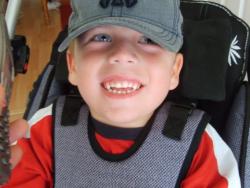What is the cause? The gene called CLN2 lies on chromosome 11. CLN2 disease is inherited as an autosomal recessive disorder, which means that both chromosomes carry mutations in the CLN2 gene, and both parents are unaffected carriers. The gene was discovered in 1998. CLN2 normally directs production of a lysosomal enzyme called tripeptidyl peptidase1 or TPP1. A deficiency of TPP1 results in abnormal setorage of proteins and lipids in neurons and other cells and impaired cellular function. The cells cannot function as they should and symptoms develop.

How is it diagnosed? The diagnosis is usually made by enzyme (TPP1) and genetic (CLN2) tests on blood samples. Occasionally a skin biopsy may be necessary. Curvilinear bodies (CVB) are the characteristic storage body at the electron microscope level.
Does it have any alternative name? CLN2 late infantile disease is sometimes called Jansky-Bielschowsky Disease or late infantile NCL (LINCL).
How common is it? 5-6 children are diagnosed with late-infantile Batten disease each year in the UK. We estimate there are between 30 and 50 affected children in the UK. Children have been diagnosed in many countries and from a variety of ethnic backgrounds.
How does the disease progress? Children are healthy and develop normally for the first few years of life. Towards the end of the second year, developmental progress may start to slow down. Some children are slow to talk. The first definite sign of the disease is usually epilepsy. Seizures may be drops, vacant spells or motor seizures with violent jerking of the limbs and loss of consciousness. Seizures may be controlled by medicines for several months but always recur, becoming difficult to control. Children tend to become unsteady on their feet with frequent falls and gradually skills such as walking, playing and speech are lost. Children become less able and gradually skills such as walking, playing and speech are lost. Children become less able, and increasingly dependent. By 4-5 years the children usually have myoclonic jerks of their limbs and head nods. They may have difficulties sleeping and become distressed around this time, often for no obvious reason. Vision is gradually lost. By the age of 6 years, most will be completely dependent on families and carers for all of their daily needs. They may need a feeding tube and their arms and legs may become stiff. Some children get frequent chest infections. Death usually occurs between the ages of 6 and 12 years (but occasionally later). Dr Ruth Williams (NCL2012 Abstract Book, Clinical Summaries 2012)
Treatment In 2018 a treatment became available for CLN2 known as Brineura® initially being delivered at Great Ormond Street Hospital and now being extended to other centres in the United Kingdom. The treatment is demonstrating that the physical decline can be slowed. More details can be found on our Brineura for CLN2 page.
A mother of a child with Late Infantile Batten Disease talks about her family’s experience.
